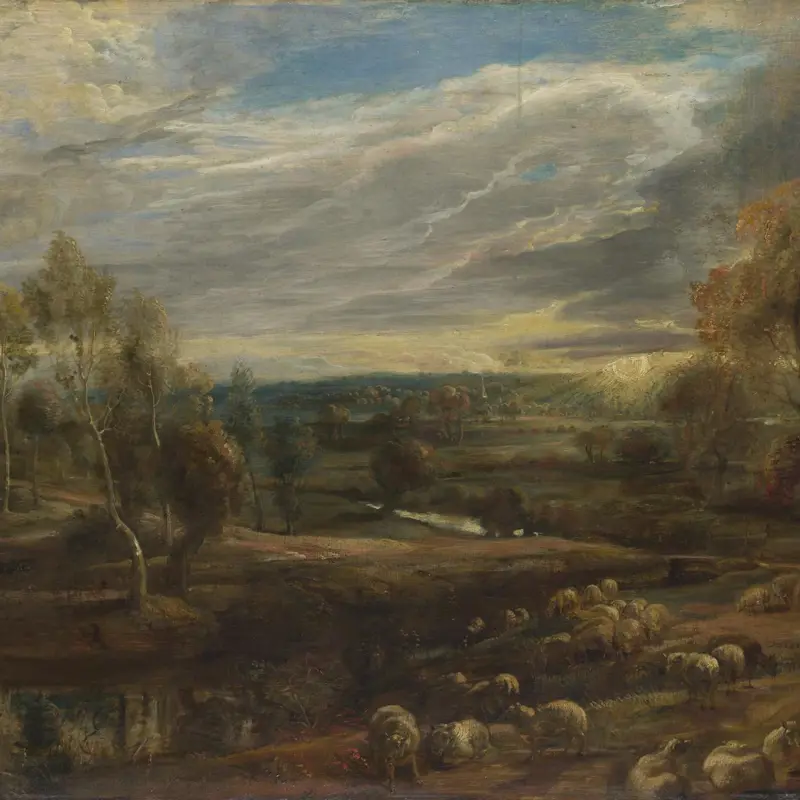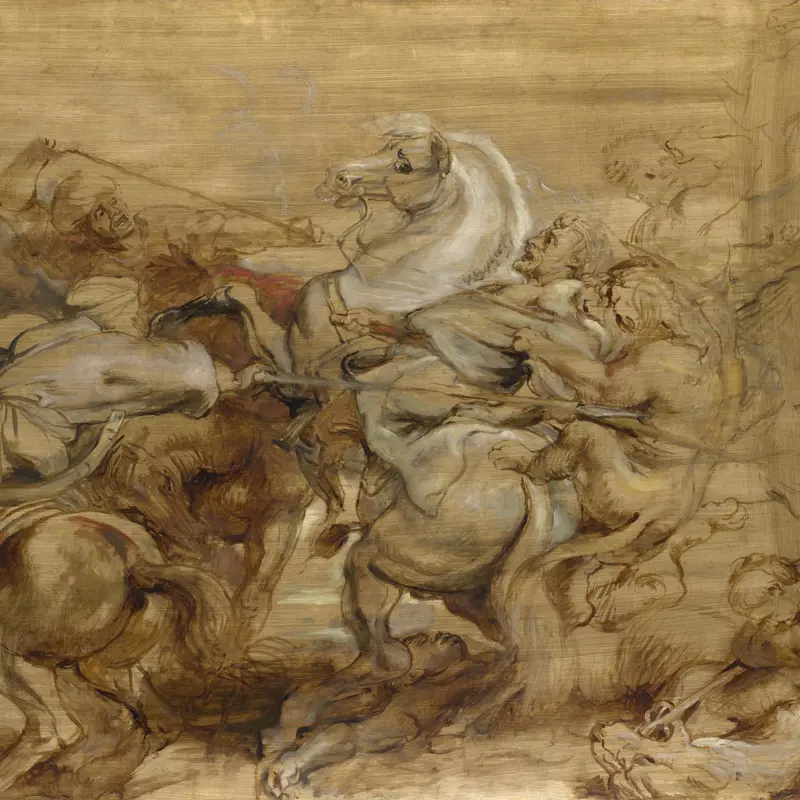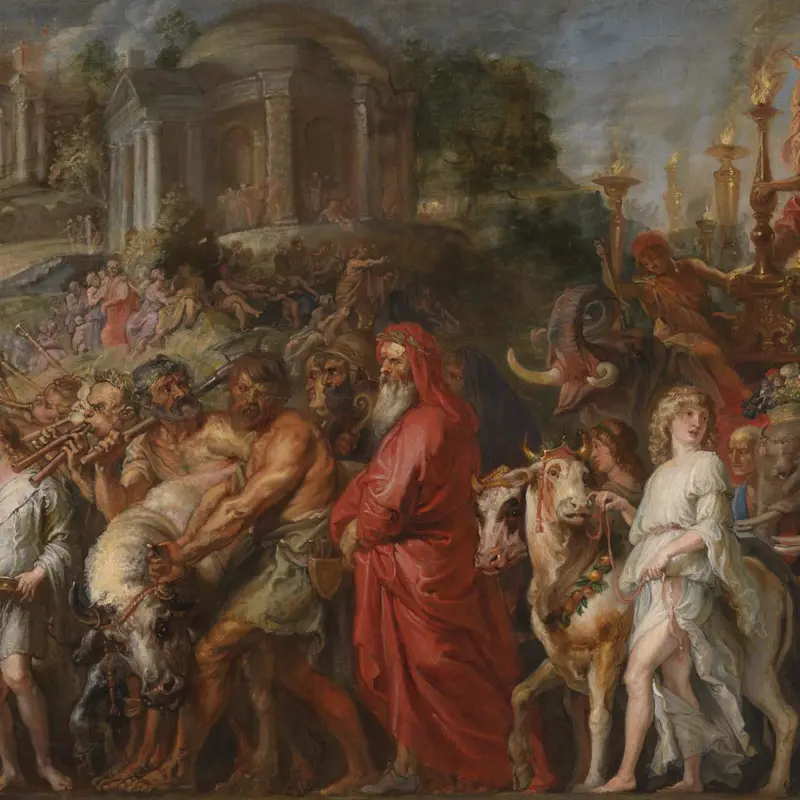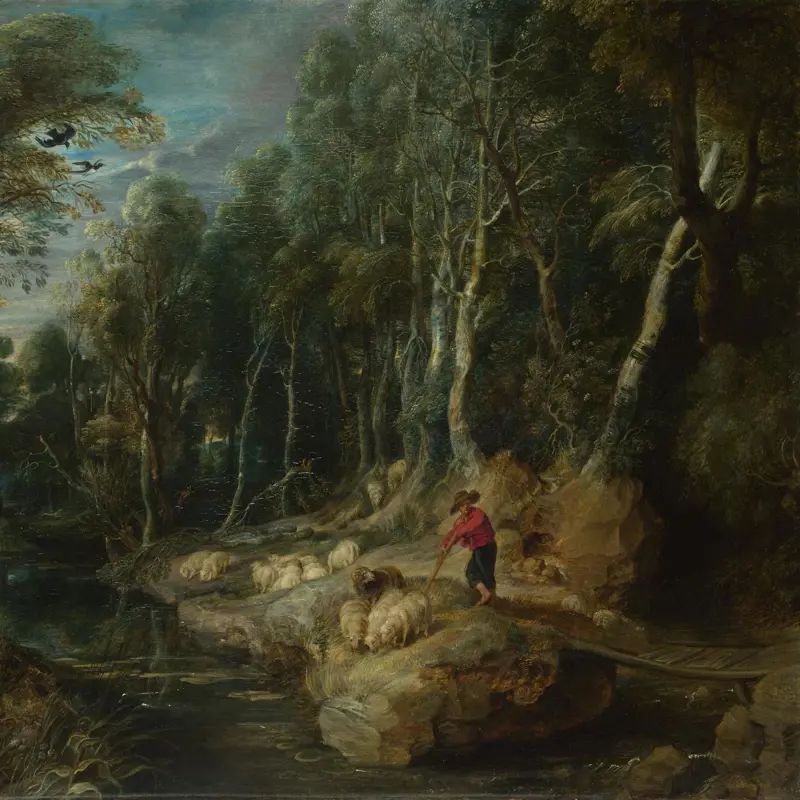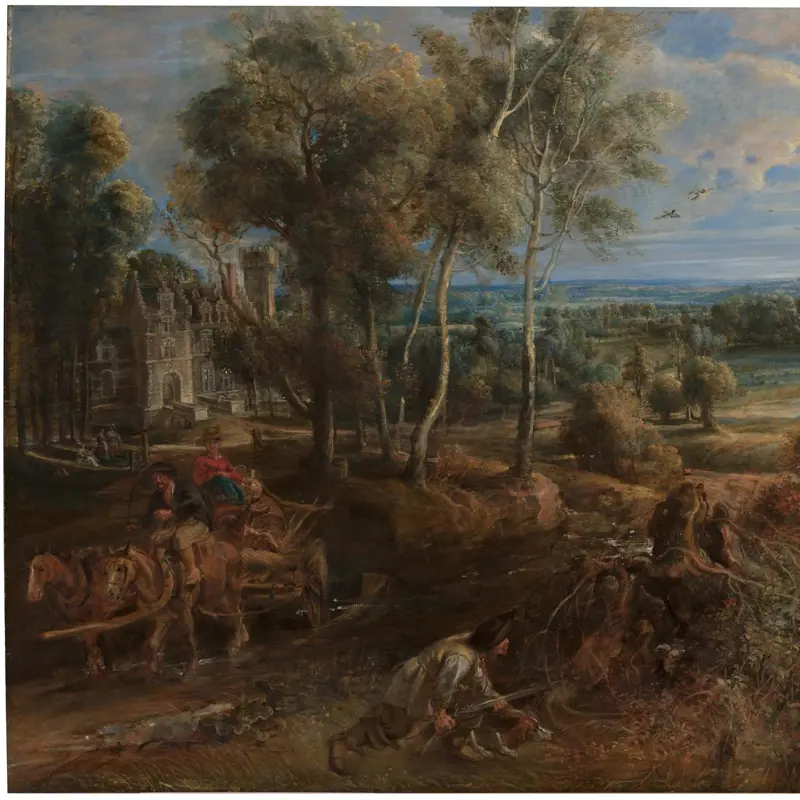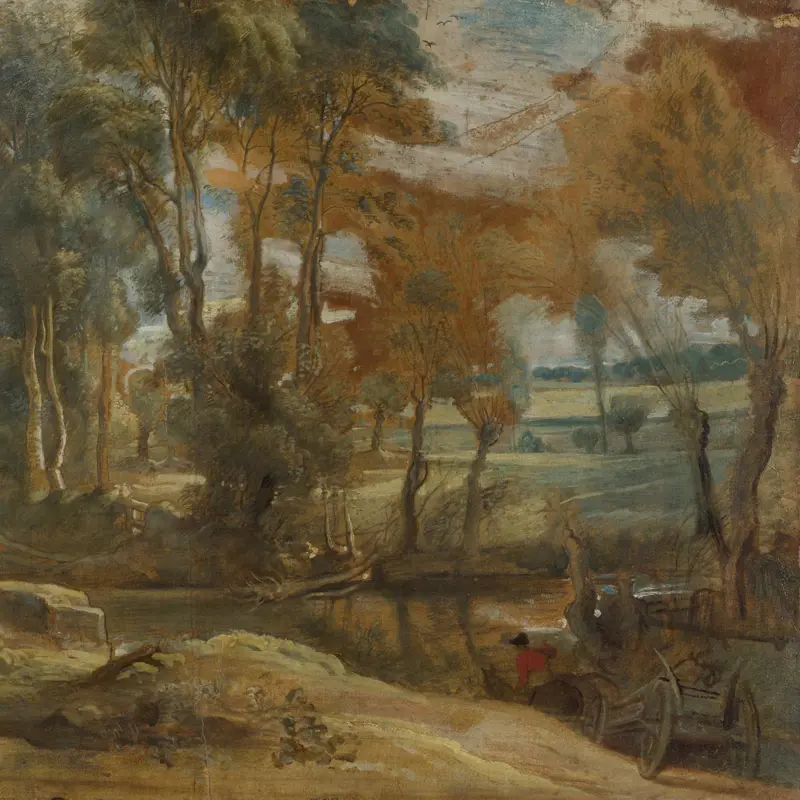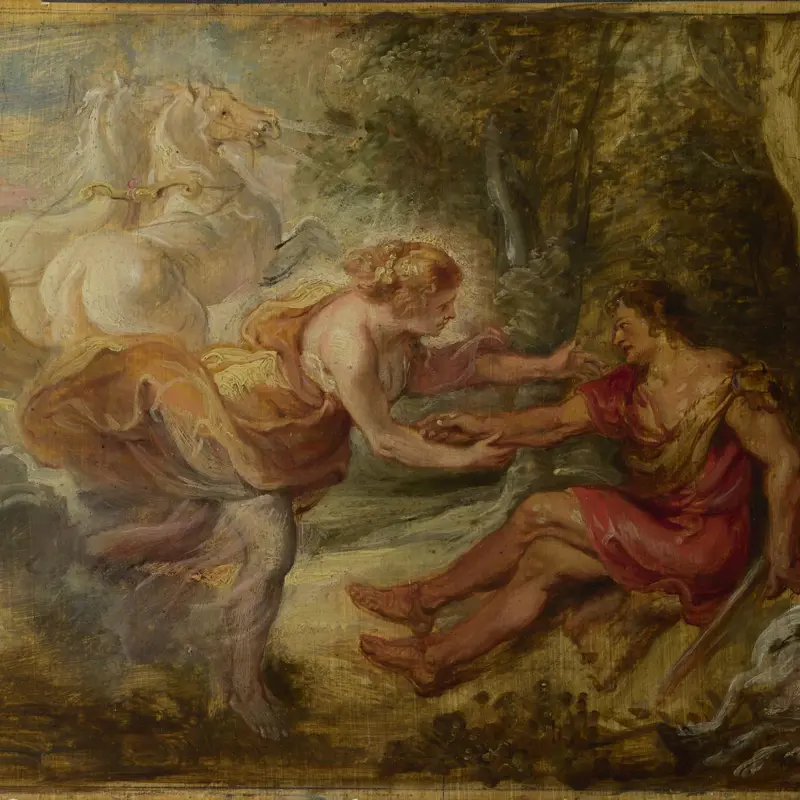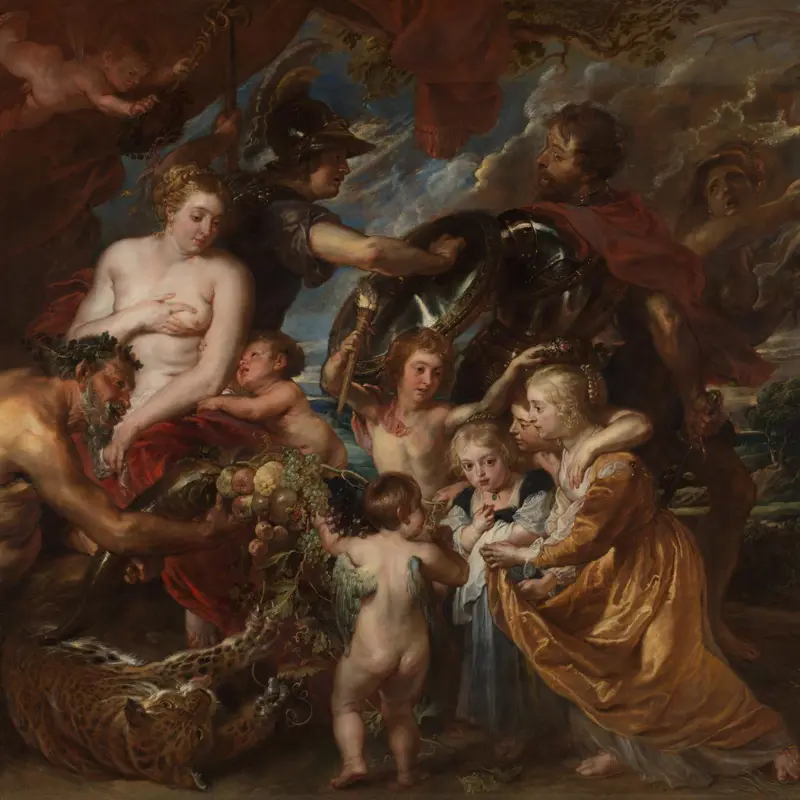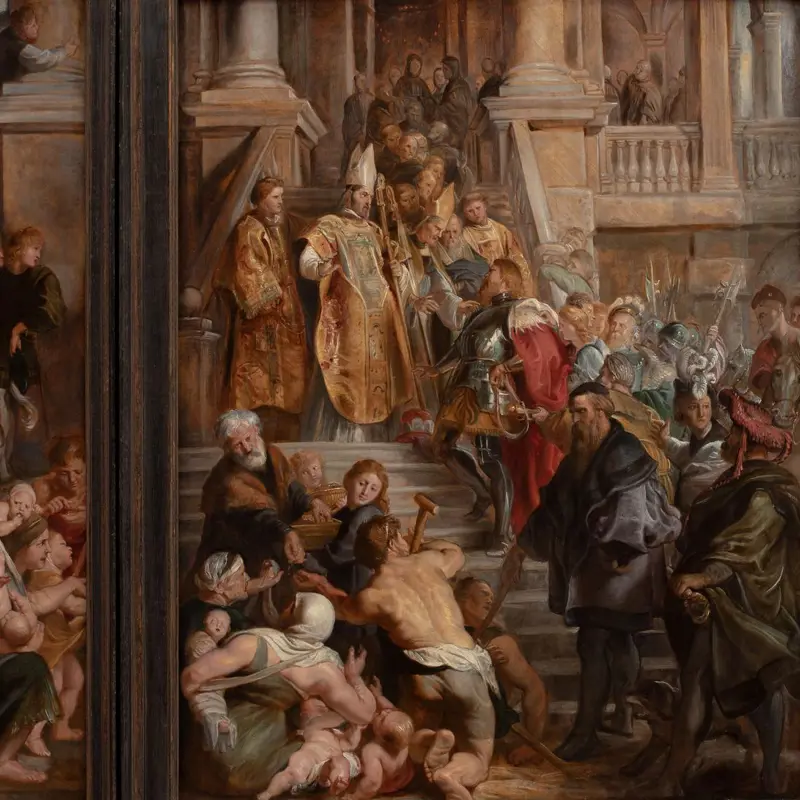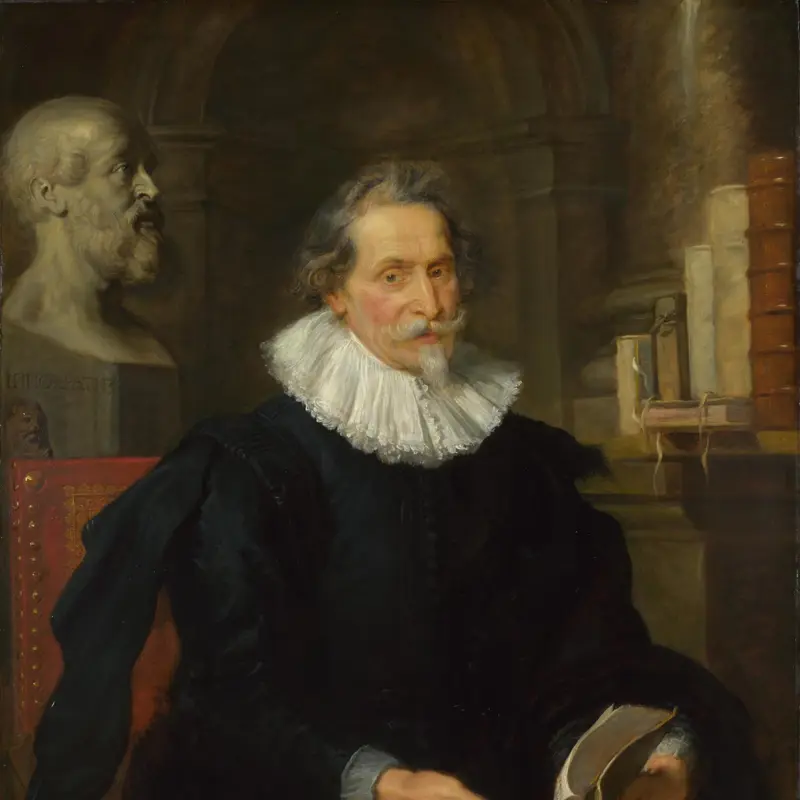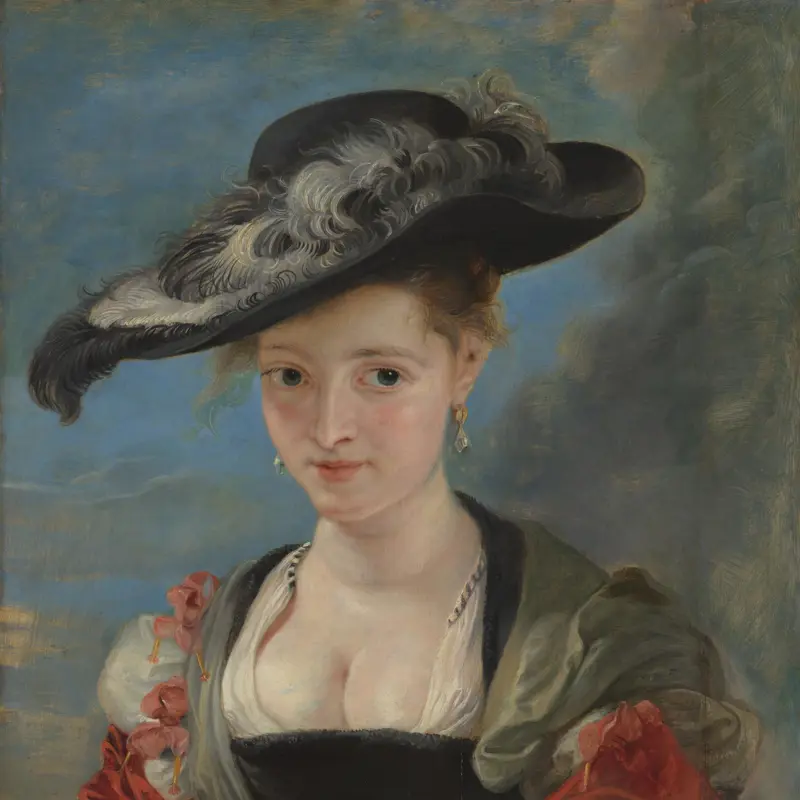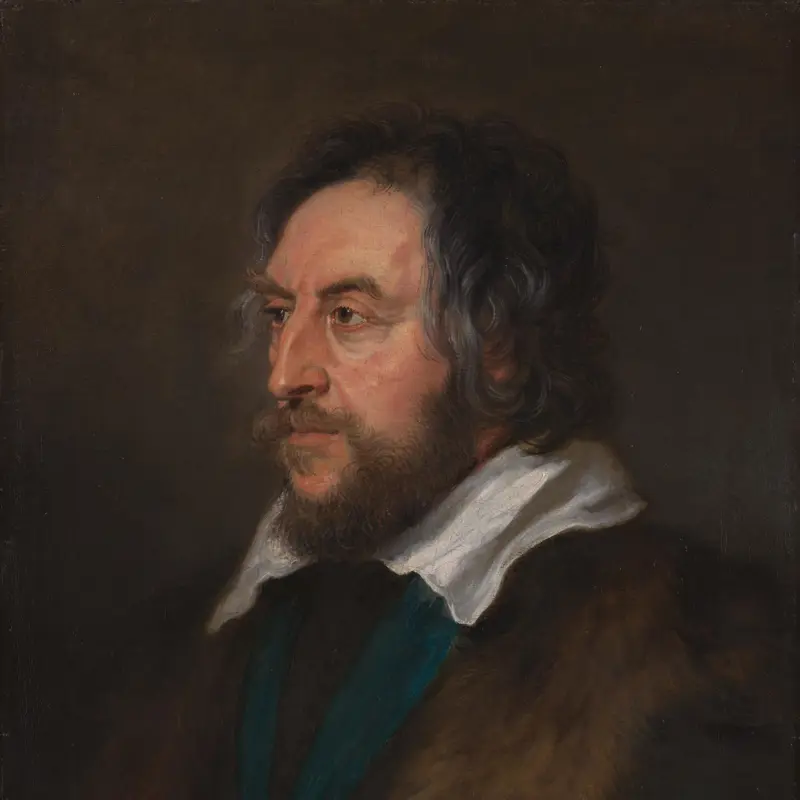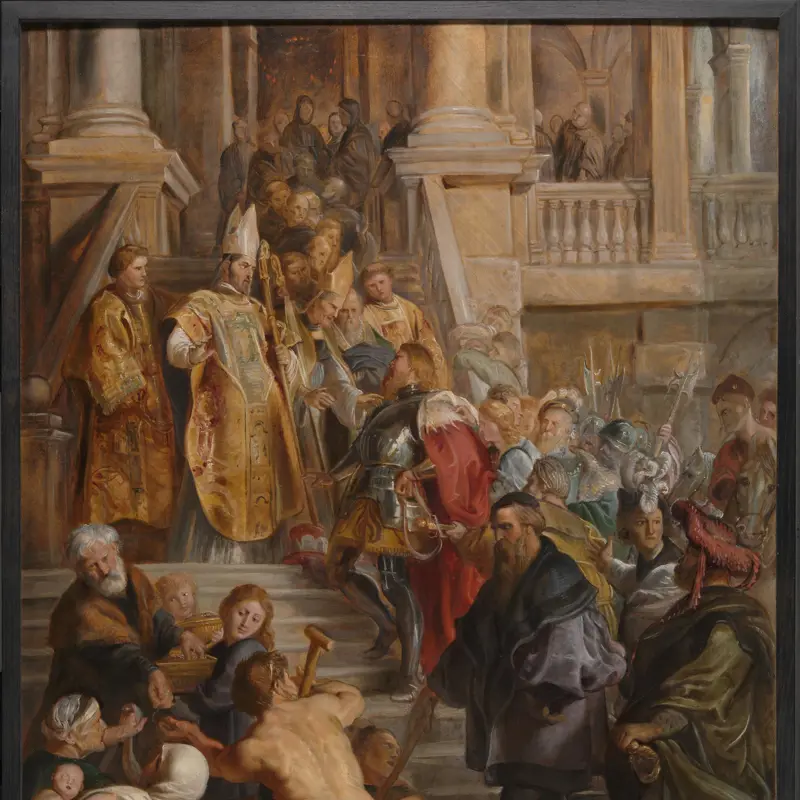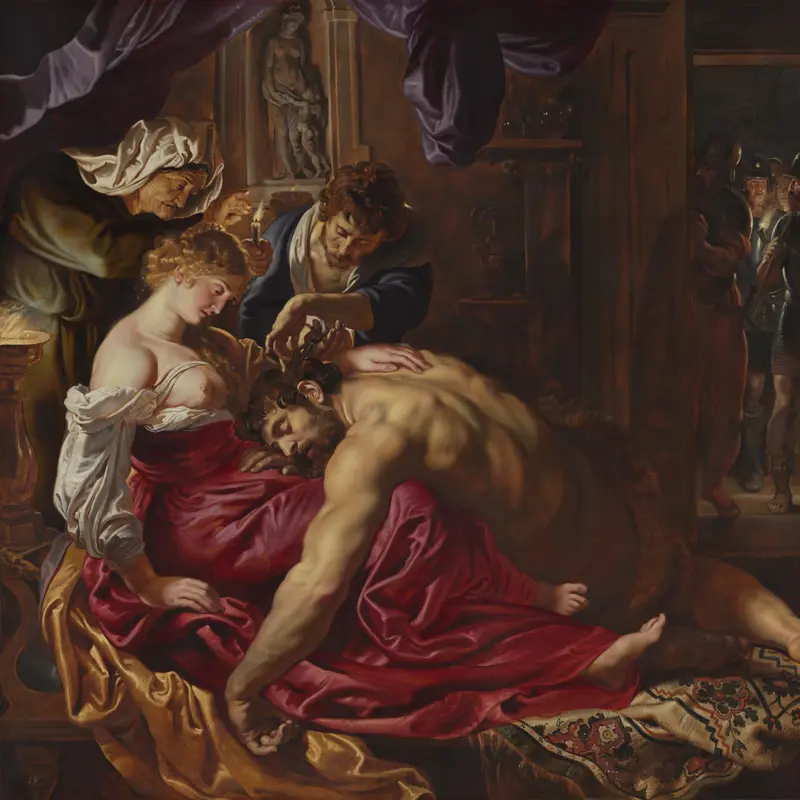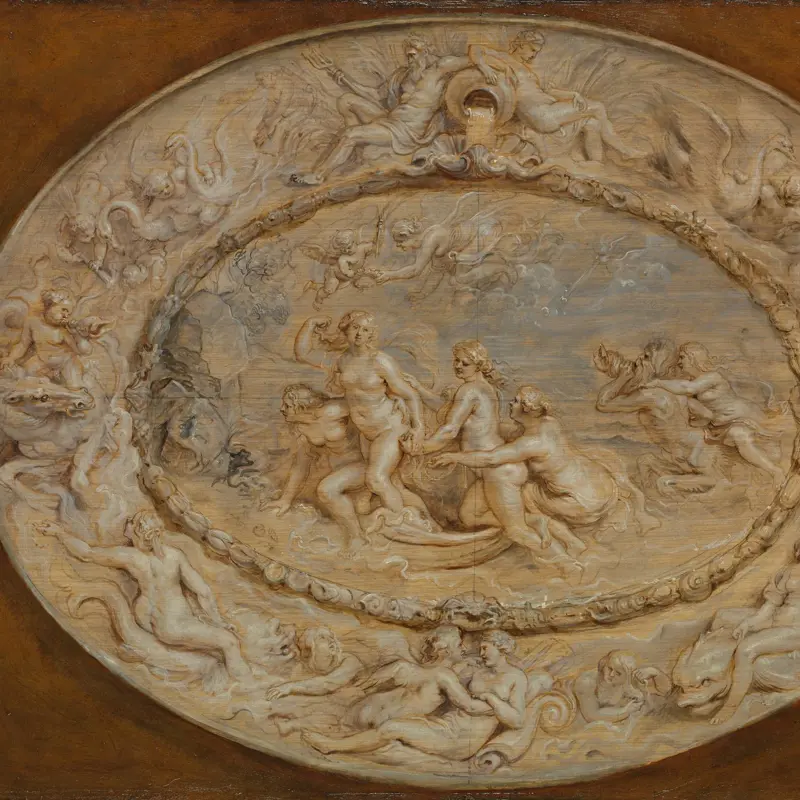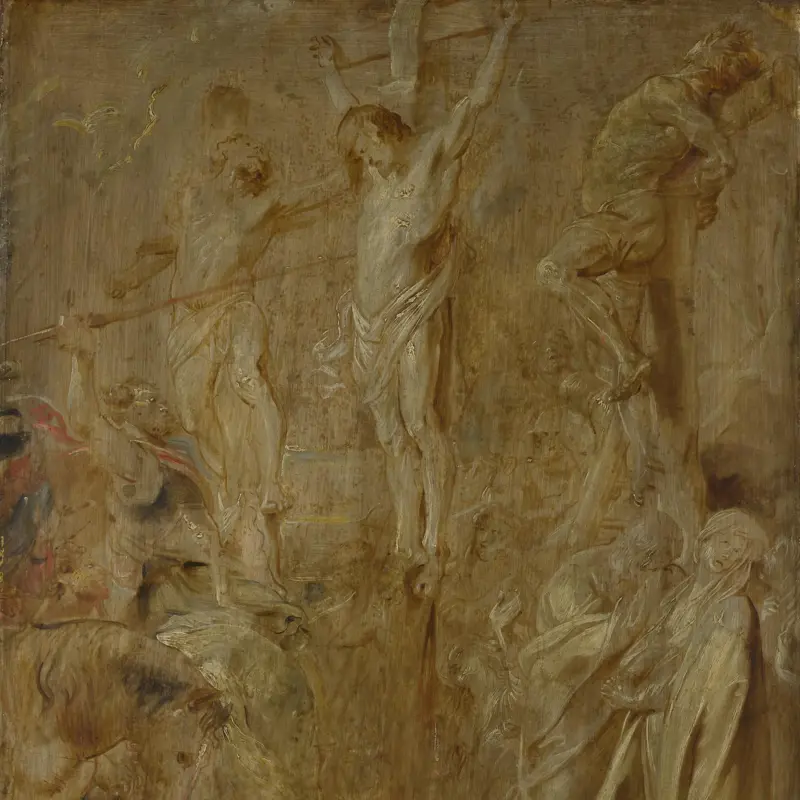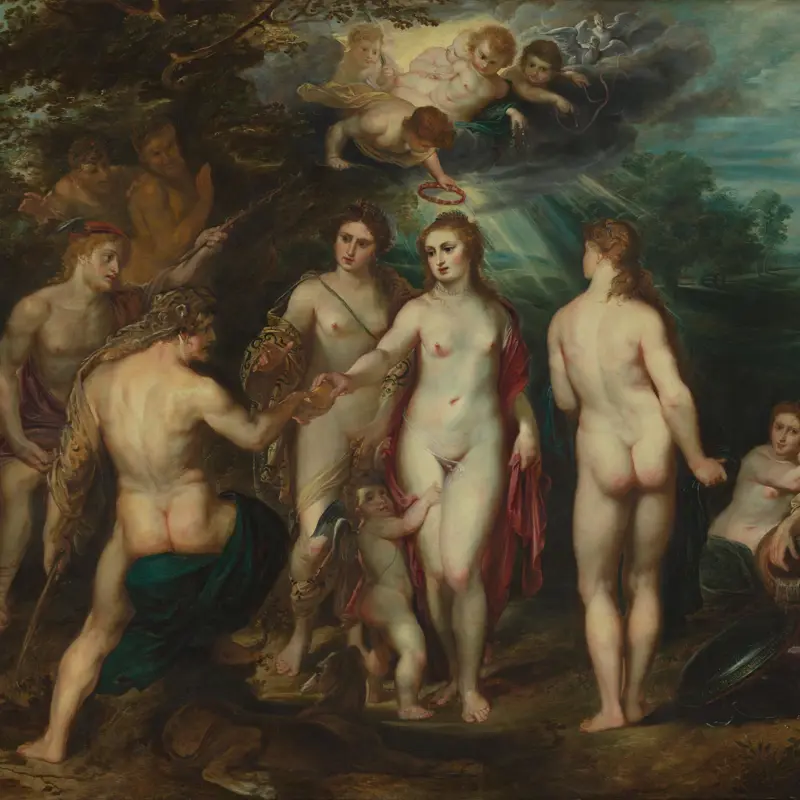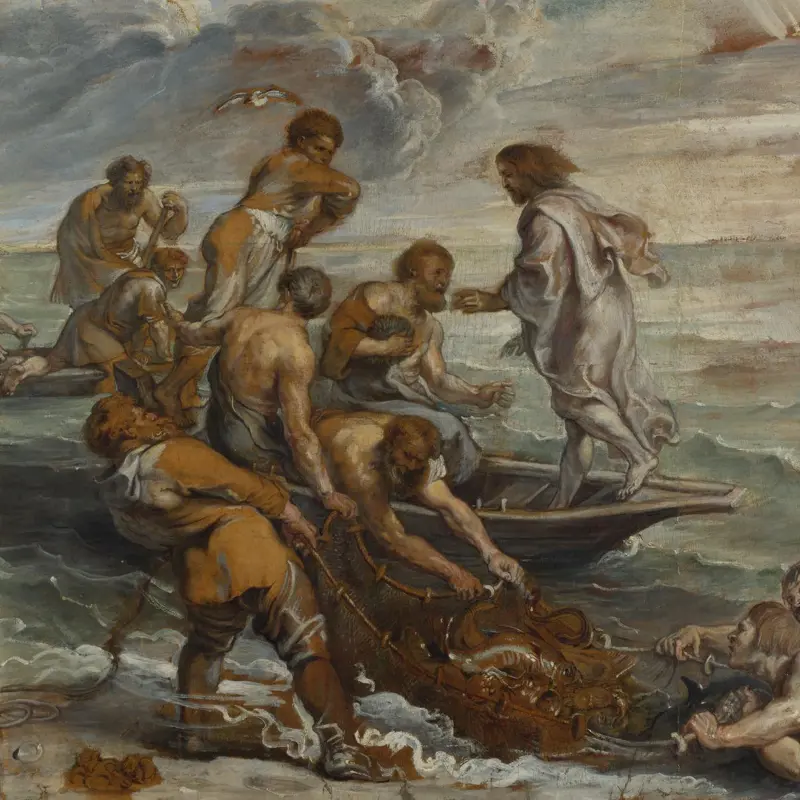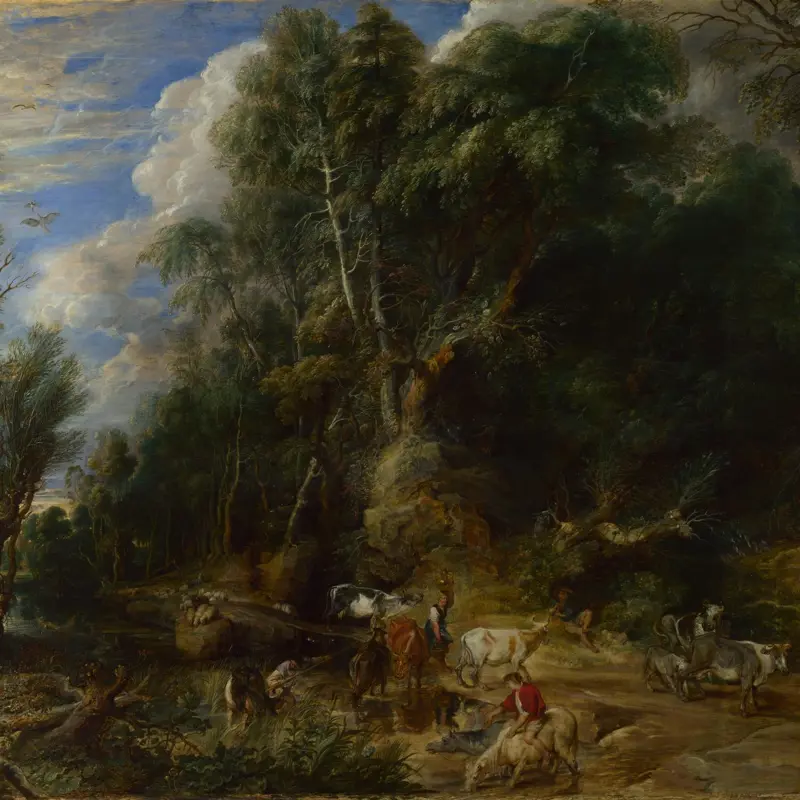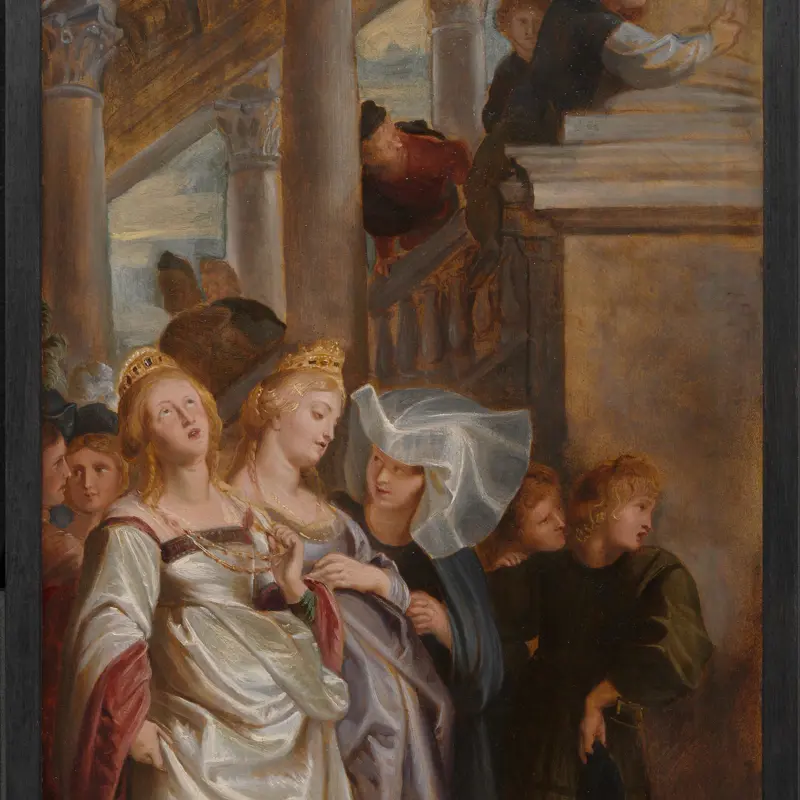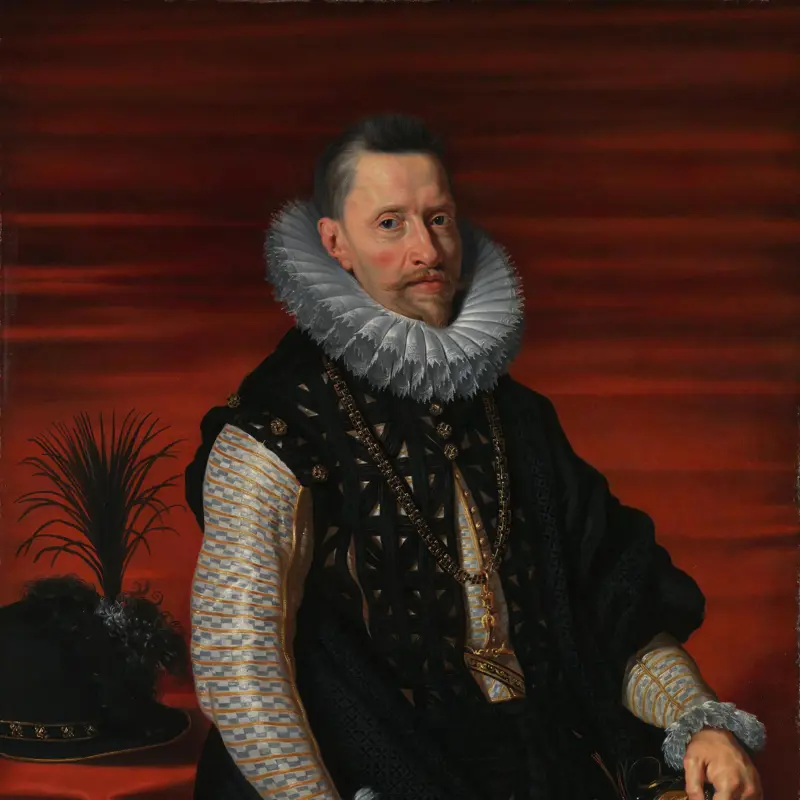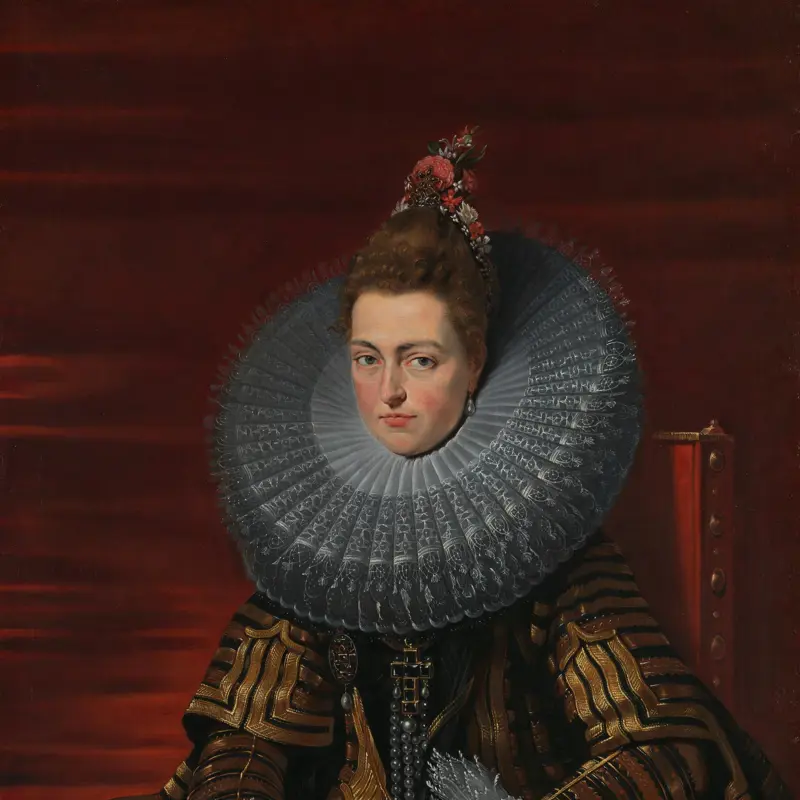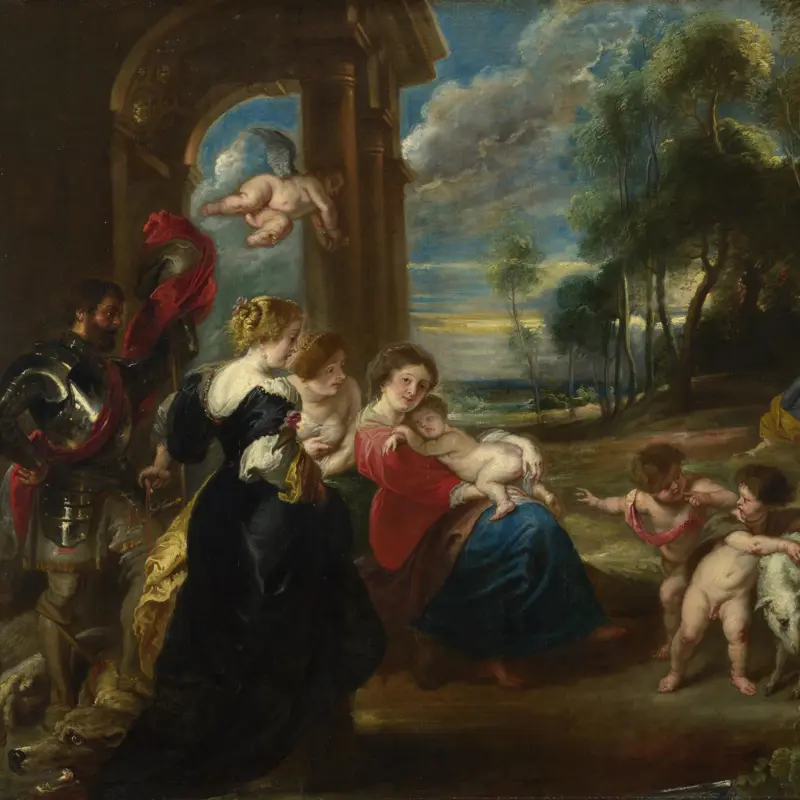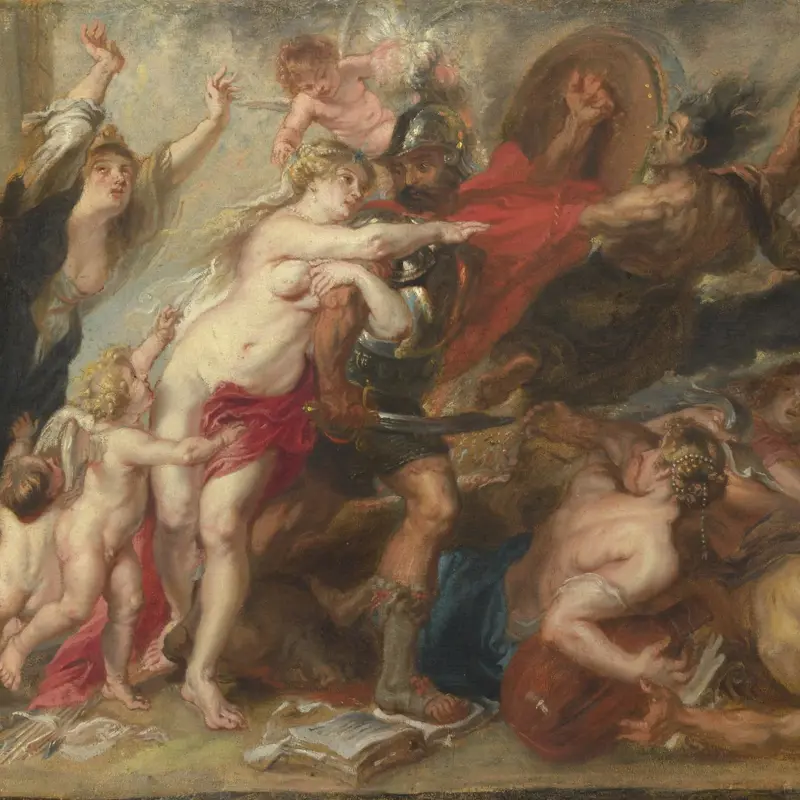Peter Paul Rubens, 'The Judgement of Paris', probably 1632-5
About the work
Overview
Eris, goddess of discord, was the only immortal not invited to an important wedding. Furious at being left out, she threw a golden apple inscribed ‘To the Fairest’ among all the goddesses at the feast. Three claimed the title – Minerva, Juno and Venus. Jupiter, chief of the gods, declared that Paris should be the judge. The young man had been raised as a shepherd, but was actually a prince of Troy.
It is this moment of choice that Rubens has depicted: Paris hands the golden apple to Venus, goddess of beauty, in the centre. The goddesses had all cheated. Juno offered Paris wealth and power, Minerva offered wisdom and strength. Venus promised him the most beautiful woman in the world, Helen of Sparta – an irresistible gift.
In the clouds above their heads is the implacable Fury, Alecto. In a jealous rage, Juno commanded her to destroy the Trojans. She caused Paris to abduct Helen, and the famous Trojan War began.
Key facts
Details
- Full title
- The Judgement of Paris
- Artist
- Peter Paul Rubens
- Artist dates
- 1577 - 1640
- Date made
- probably 1632-5
- Medium and support
- oil on wood
- Dimensions
- 144.8 × 193.7 cm
- Acquisition credit
- Bought, 1844
- Inventory number
- NG194
- Location
- Room 18
- Collection
- Main Collection
- Frame
- 17th-century French Frame
Provenance
Additional information
Text extracted from the ‘Provenance’ section of the catalogue entry in Gregory Martin, ‘National Gallery Catalogues: The Flemish School: circa 1600–circa 1900’, London 1986; for further information, see the full catalogue entry.
Exhibition history
-
2017Rubens and RembrandtThe National Gallery (London)22 March 2017 - 6 August 2017
Bibliography
-
1626V. Cartari, Imagini degli dei degli antichi, Padua 1626
-
1665B. de Monconys, Journal des voyages de monsieur de Monconys, 3 vols, Lyon 1665
-
1672G.P. Bellori, Le vite de'pittori, Rome 1672
-
1677R. de Piles, Conversations sur la connoissance de la peinture, et sur le jugement qu'on doit faire des tableaux: Où par occasion il est parlé de la vie de Rubens, & de quelques-uns de ses plus beaux ouvrages, Paris 1677
-
1681R. de Piles, Dissertation sur les ouvrages des plus fameux peintres: Dediée à Monseigneur le Duc de Richelieu, Paris 1681
-
1727L.D. de Saint-Gelais, Description des tableaux du Palais Royal: Avec la vie des peintres à la tête de leurs ouvrages: Dédiée à Monseigneur le duc d'Orleans, premier prince du sang, Paris 1727
-
1733M.L.R., Les curiositéz de Paris, de Versailles, de Marly, de Vincennes, de S. Cloud, et des environs, Paris 1733
-
1749A.-N. Dézallier d'Argenville, Voyage pittoresque de Paris, ou, Indication de tout ce qu'il y a de plus beau dans cette grande ville, en peinture, sculpture, & architecture, Paris 1749
-
1754Recueil d'estampes gravées d'aprez les tableaux de la Galerie et du Cabinet de S. E. Mr. le Comte de Bruhl, Dresden 1754
-
1793125 Pall Mall, The Orleans Gallery, Now Exhibiting at the Great Rooms, Late the Royal Academy, Now 125 Pall Mall, April 1793, London, April 1793 - June 1793
-
1796'Whitley Papers Report', Oracle, X, 1796
-
1811Phillips, Catalogue of a Genuine and Highly Select Collection of Sixteen Pictures…collected by a Nobleman, London, 21 May 1811
-
1813Phillips, A Catalogue of Lord Kinnaird's Collection of Valuable Original Pictures, London, 4 March 1813 - 5 March 1813
-
1824W. Buchanan, Memoirs of Painting: With a Chronological History of the Importation of Pictures by the Great Masters into England Since the French Revolution, London 1824
-
1829
J. Smith, A Catalogue Raisonné of the Works of the Most Eminent Dutch, Flemish, and French Painters: In Which is Included a Short Biographical Notice of the Artists, with a Copious Description of Their Principal Pictures […], 9 vols, London 1829-1842
-
1829J. Stacey, 'Thomas Penrice's Collection, Yarmouth', in A General History of the County of Norfolk, Norwich 1829, vol. 1
-
1836S. Wilkin (ed.), Sir Thomas Browne's Works, London 1836
-
1844Christie & Manson, Catalogue of the Celebrated Collection of Pictures, of the Very Highest Class: The Property of John Penrice, Esq., London, 16 July 1844
-
1845G. Foggo, A Catalogue of the Pictures in the National Gallery with Critical Notes, London 1845
-
1845T. Penrice, Letters Addressed to the Late Thomas Penrice, Esq., while Engaged in Forming His Collection of Pictures, 1808-1814, ed. J. Penrice, Yarmouth 1845
-
1847R.N. Wornum, Descriptive and Historical Catalogue of the Pictures in the National Gallery, London 1847
-
1853National Gallery, Report from the Select Committee on the National Gallery, together with the Proceedings of the Committee, Minutes of Evidence, Appendix, and Index, London 1853
-
1853London, National Gallery Archive, NG15/3: Report from the Select Committee on the National Gallery, together with the Proceedings of the Committee, Minutes of Evidence, Appendix, and Index, 1853
-
1856J. Hübner, Catalogue des tableaux de la galerie royale de Dresde, trans. L. Grainger, Dresden 1856
-
1864P.F. Rombouts and T. van Lerius, De Liggeren en Andere Historisce Archieven der Antwerpsche Sint Lucasgilde, 2 vols, Antwerp 1864
-
1868J. Bruce (ed.), Calendar of State Papers, Domestic Series, in the Reign of Charles I, 1636-8, London 1868
-
1868R.N. James et al., National Exhibition of Works of Art, Leeds, 1868 (exh. cat. Leeds Infirmary, 1868), Leeds 1868
-
1870F. Muller, 'Catalogus der schilderijen van Diego Duarte, te Amsterdam in 1682, met de prijzen van aankoop en taxatie', De Oude Tijd, II, 1870, pp. 397-402
-
1877A. Goovaerts et al., L'œuvre de P. P. Rubens: Catalogue de l'exposition organisée sous les auspices de l'administration communale d'Anvers (exh. cat. Koninklijk Museum voor Schone Kunsten, 1877), Antwerp 1877
-
1878H. Blackburn, Illustrated Catalogue to the National Gallery: Foreign Schools, London 1878
-
1882W.J.A. Jonckbloet and J.P.N. Lands (eds), Musique et musiciens au XVIIe siècle: Correspondance et oeuvre musicales de Constantin Huygens, Leiden 1882
-
1882E. Bonnaffé, 'Notes sur les collections des richelieu', Gazette des beaux-arts, II, 1882, pp. 96-112
-
1883P. Rubens, 'Memoire 1676', Rubens-Bulletijn, II, 1883
-
1886M. Rooses, L'œuvre de P. P. Rubens: Histoire et description de ses tableaux et dessins, 5 vols, Antwerp 1886-92
-
1887M.-F. Reiset, Une visite à la Galerie nationale de Londres, 2nd revised edn, Rapilly 1887
-
1887K. Woermann, Katalog der königlichen Gemäldegalerie zu Dresden, Dresden 1887
-
1887W. Armstrong, 'Notes on the National Gallery', The Guardian, 1887
-
1888E.T. Cook, A Popular Handbook to the National Gallery Including, by Special Permission, Notes Collected from the Works of Mr. Ruskin, London 1888
-
1900V. Champier and G.-R. Sandoz, Le Palais-Royal d'après des documents inédits, Paris 1900
-
1900G. Upmark, 'Ein Besuch in Holland, 1687', Oud Holland, XVIII, 1900, pp. 117-28
-
1904M.H. Witt, The German and Flemish Masters in the National Gallery, London 1904
-
1905A. Rosenberg, P. P. Rubens: Des Meisters Gemälde in 551 Abbildungen, ed. R. Oldenbourg, Stuttgart 1905
-
1906'Half Holidays at the National Gallery', Pall Mall Gazette, 1906
-
1909M. Rooses and C.L. Ruelens, Correspondance de Rubens, Antwerp 1909
-
1910Exposition d'art ancient: L'art belge au XVIIe siècle (exh. cat.exh. cat.), Bruxelles 1910 Brussels, 1910), Bruxelles 1910
-
1913H.F. Cook (ed.), A Catalogue of the Paintings at Doughty House, Richmond and Elsewhere in the Collection of Sir Frederick Cook, Bt, 3 vols, London 1913
-
1913C. Stryienski, La galerie du régent, Philippe, duc d'Orléans, Paris 1913
-
1914Musée d'Anvers, Exposition du Musée d'Anvers (exh. cat. Musée d'Anvers, 1914), Antwerp 1914
-
1916R.A. Peltzer, 'Hans Rottenhammer', Jahrbuch der Kunsthistorischen Sammlungen des allerhöchsten Kaiserhauses, XXXIII/40, 1916
-
1921R. Oldenbourg and A. Rosenberg, P. P. Rubens. Klassiker der Kunst in Gesamtausgaben, Stuttgart 1921
-
1921Lucian III, trans. A.M. Harmon, Loeb Classical Library 130, London 1921
-
1922J. Farington, The Farington Diary, ed. J. Greig, 8 vols, London 1922
-
1923G. Gronau, Raffael, Stuttgart 1923
-
1925C.J. Holmes, Old Masters and Modern Art: The National Gallery, the Netherlands, Germany and Spain, London 1925
-
1928L. Burchard, 'Die neuerworbene Landschaft von Rubens im Kaiser-Friedrich-Museum', Jahrbuch der Preussischen Kunstsammlungen, XLIX/1, 1928, pp. 62-8
-
1928G. Glück and F.M. Halberditzl, Die Handzeichnungen von Peter Paul Rubens, Berlin 1928
-
1928L. Burchard, 'Alcuni dipinti del Rubens nel suo periodo italiano', Pinacotheca, I/1, 1928, pp. 14-6
-
1929National Gallery, National Gallery, Trafalgar Square: Catalogue, 86th edn, London 1929
-
1930T. Cox, The National Gallery: A Room to Room Guide, London 1930
-
1931J. Denucé, Art-Export in the 17th Century: The Firm of Forchondt, Antwerp 1931
-
1932M.A. Cornette, Trésor de l'art Flamand du Moyen Age au XVIIIme siècle: Mémorial de l'exposition d'art Flamend ancient à Anvers 1930, par un groupe de spécialiste, Paris 1932
-
1932J. Denucé, The Antwerp Art-Galleries: Inventories of the Art-Collections in Antwerp in the 16th and 17th Centuries, Antwerp 1932
-
1940F. van den Wijngaert, Inventaris der Rubeniaansche prentkunst, Antwerp 1940
-
1947P. Hendy, An Exhibition of Cleaned Pictures of 1947: (1936-1947), London 1947
-
1948O. Fischel, Raphael, trans. B. Rackham, London 1948
-
1949J. Denucé, Na Peter Pauwel Rubens: Documenten uit den kunsthandel te Antwerpen in de XVII eeuw van Matthijs Musson, Antwerp 1949
-
1949F. Lugt, Inventaire général des dessins des écoles du Nord, 2 vols, Paris 1949
-
1955The Diary of John Evelyn, ed. E.S. de Beer, 6 vols, Oxford 1955, vol. 5
-
1957K.T. Parker and J. Mathey, Antoine Watteau: Catalogue complet de son oeuvre dessiné, Paris 1957
-
1958M. Levey, Twenty-Four Masterpieces from the National Gallery, London, London 1958
-
1959J. Held, Rubens: Selected Drawings, London 1959
-
1963B. Teyssèdre, 'Une collection de Rubens au XVIIe siècle: Le cabinet du duc de Richelieu décrit par Roger de Piles (1676 - 1681)', Gazette des beaux-arts, LXII, November 1963, pp. 241-300
-
1963L. Burchard and R.-A. d'Hulst, Rubens Drawings, Brussels 1963
-
1967M. Jaffé, 'Rubens and Raphael', in Studies in Renaissance and Baroque Art presented to Anthony Blunt, London 1967, pp. 98-107
-
1968M. Jaffé, 'Rubens in Italy II: Some Rediscovered Works of the First Phase', The Burlington Magazine, CX/781, 1968, pp. 174-87
-
1968J. Thuillier, 'Doctrines et querelles artistiques en France au début du XVIIe siecle: Quelques textes oubliés ou inédits', Archives de l'art Français, XXIII, 1968, pp. 125-217
-
1970G. Martin, The Flemish School, circa 1600-circa 1900, London 1970
-
1977M. Jaffé, Rubens and Italy, Oxford 1977
-
1978C. Gould, The Draped Figure, Themes and Painters in the National Gallery 2, 2nd edn, London 1978
-
1979A. Braham, Rubens, Themes and Painters in the National Gallery 8, London 1979
-
1984D. Sutton, 'Aspects of British Collecting, III.XIII: The Orléans Collection', Apollo, CXIX/267, 1984, pp. 357-72
-
1986Martin, Gregory, National Gallery Catalogues: The Flemish School, circa 1600 - circa 1900, London 1986
-
1987F. Woolf and M. Cassin, Bodylines: The Human Figure in Art, (exh. cat. The National Gallery, London, 18 March - 17 May 1987), London 1987
-
1989M. Jaffé, Rubens: Catalogo completo, Milan 1989
-
1989C. Scribner, Peter Paul Rubens, New York 1989
-
1989J. Müller Hofstede, '"Stolidi Iudicium Paridis": Zur Ikonologie des Parisurteils bei Peter Paul Rubens', Wallraf-Richartz-Jahrbuch, L, 1989, pp. 163-87
-
1991R. Kendall, Van Gogh to Picasso: The Berggruen Collection at the National Gallery (exh. cat. The National Gallery, 16 January - 21 April 1991), London 1991
-
1992H. Damisch, Le Jugement de Pâris, Paris 1992
-
1992M. Vidal, Watteau's Painted Convesations: Art, Literature and Talk in Seventeenth- and Eighteenth-Century France, New Haven 1992
-
1994A. Schnapper, Curieux du Grand Siècle: Collections et collectionneurs dans la France du XVIIe siècl, Paris 1994
-
1996O. von Simson, Peter Paul Rubens (1577-1640): Humanist, Maler und Diplomat, Mainz 1996
-
1997F. Healy, Rubens and the Judgement of Paris: A Question of Choice, Turnhout 1997
-
2001
C. Baker and T. Henry, The National Gallery: Complete Illustrated Catalogue, London 2001
-
2004R. Rosenberg, 'Une ligne horizontale interrompue par une ligne diagonale', in O. Bonfait (ed.), La description de l'œuvre d'art: Du modèle classique aux variations contemporaines, Paris 2004, pp. 55-74
-
2005L. Oliver et al., 'The Evolution of Rubens's "Judgement of Paris" (NG194)', National Gallery Technical Bulletin, XXVI/1, 2005, pp. 4-22
-
2010D. Jaffé, 'Rubens's Lost "Pocketbook": Some New Thoughts', The Burlington Magazine, CL/1260, 2010, pp. 173-81
About this record
If you know more about this work or have spotted an error, please contact us. Please note that exhibition histories are listed from 2009 onwards. Bibliographies may not be complete; more comprehensive information is available in the National Gallery Library.

